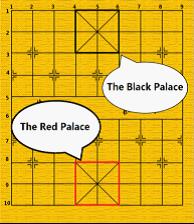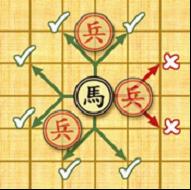HDU 4121 Xiangqi 模拟题
Xiangqi
Time Limit: 20 Sec
Memory Limit: 256 MB
题目连接
http://acm.hdu.edu.cn/showproblem.php?pid=4121
Description
Now
we introduce some basic rules of Xiangqi. Xiangqi is played on a 10×9
board and the pieces are placed on the intersections (points). The top
left point is (1,1) and the bottom right point is (10,9). There are two
groups of pieces marked by black or red Chinese characters, belonging to
the two players separately. During the game, each player in turn moves
one piece from the point it occupies to another point. No two pieces can
occupy the same point at the same time. A piece can be moved onto a
point occupied by an enemy piece, in which case the enemy piece is
"captured" and removed from the board. When the general is in danger of
being captured by the enemy player on the enemy player’s next move, the
enemy player is said to have "delivered a check". If the general's player can make no move to prevent the general's capture by next enemy move, the situation is called “checkmate”.
We only use 4 kinds of pieces introducing as follows: General: the generals can move and capture one point either vertically or horizontally and cannot leave the “palace” unless the situation called “flying general”
General: the generals can move and capture one point either vertically or horizontally and cannot leave the “palace” unless the situation called “flying general”
(see the figure above). “Flying general” means that one general can
“fly” across the board to capture the enemy general if they stand on the
same line without intervening pieces. Chariot: the chariots can move and capture vertically and horizontally by any distance, but may not jump over intervening pieces
Chariot: the chariots can move and capture vertically and horizontally by any distance, but may not jump over intervening pieces Cannon: the cannons move like the chariots, horizontally and vertically, but capture by jumping exactly one piece (whether it is friendly or enemy) over to its target.
Cannon: the cannons move like the chariots, horizontally and vertically, but capture by jumping exactly one piece (whether it is friendly or enemy) over to its target. Horse:
Horse:
the horses have 8 kinds of jumps to move and capture shown in the left
figure. However, if there is any pieces lying on a point away from the
horse horizontally or vertically it cannot move or capture in that
direction (see the figure below), which is called “hobbling the horse’s leg”.

Now
you are given a situation only containing a black general, a red
general and several red chariots, cannons and horses, and the red side
has delivered a check. Now it turns to black side’s move. Your job is to
determine that whether this situation is “checkmate”.
Input
There is a blank line between two test cases. The input ends by 0 0 0.
Output
For each test case, if the situation is checkmate, output a single word ‘YES’, otherwise output the word ‘NO’.
Sample Input
2 1 4
G 10 5
R 6 4
3 1 5
H 4 5
G 10 5
C 7 5
0 0 0
Sample Output
YES
NO
HINT
题意
给你一个象棋残局,黑方只剩下一个王了。现在该王走了,是否王怎么走都会死了?
题解:
1.黑方王在走的时候,可以踩死红方棋子
2.马会被蹩脚
然后没有什么坑点了,暴力模拟就好了……
代码
#include<iostream>
#include<stdio.h>
#include<vector>
#include<cstring>
using namespace std; int n,x,y;
vector<pair<int,int> >P;
vector<pair<int,int> >H;
vector<pair<int,int> >C;
vector<pair<int,int> >G;
int dx[]={,-,,};
int dy[]={,,,-};
int vis[][];
void init()
{
P.clear();
H.clear();
C.clear();
G.clear();
memset(vis,,sizeof(vis));
}
int check(int xx,int yy)
{
//cout<<xx<<" "<<yy<<endl;
if(xx<||xx>)return ;
if(yy<||yy>)return ; for(int i=;i<C.size();i++)
{
int xxx = C[i].first, yyy = C[i].second;
if(xxx == xx && yyy == yy)
continue;
while(xxx<=)
{
xxx++;
if(xxx == xx && yyy == yy)
return ;
if(vis[xxx][yyy])
break;
}
xxx = C[i].first, yyy = C[i].second;
while(xxx)
{
xxx--;
if(xxx == xx && yyy == yy)
return ;
if(vis[xxx][yyy])
break;
}
xxx = C[i].first, yyy = C[i].second;
while(yyy<=)
{
yyy++;
if(xxx == xx && yyy == yy)
return ;
if(vis[xxx][yyy])
break;
}
xxx = C[i].first, yyy = C[i].second;
while(yyy)
{
yyy--;
if(xxx == xx && yyy == yy)
return ;
if(vis[xxx][yyy])
break;
}
}
//cout<<xx<<" "<<yy<<endl;
for(int i=;i<H.size();i++)
{
int xxx = H[i].first , yyy = H[i].second;
if(xxx == xx && yyy == yy)
continue;
if(xxx != && vis[xxx-][yyy]==)
{
if(xx == xxx - && yy == yyy + )
return ;
if(xx == xxx - && yy == yyy - )
return ;
}
if(xxx != && vis[xxx+][yyy]==)
{
if(xx == xxx + && yy == yyy + )
return ;
if(xx == xxx + && yy == yyy - )
return ;
}
if(yyy != && vis[xxx][yyy-]==)
{
if(xx == xxx + && yy == yyy - )
return ;
if(xx == xxx - && yy == yyy - )
return ;
}
if(yyy != && vis[xxx][yyy+]==)
{
if(xx == xxx + && yy == yyy + )
return ;
if(xx == xxx - && yy == yyy + )
return ;
}
}
//cout<<xx<<" "<<yy<<endl;
for(int i=;i<P.size();i++)
{
int xxx = P[i].first,yyy = P[i].second;
if(xxx == xx && yyy == yy)
continue;
int flag = ;
while(xxx<=)
{
xxx++;
if(xxx == xx && yyy == yy && flag == )
return ;
if(vis[xxx][yyy])
flag++;
}
xxx = P[i].first, yyy = P[i].second,flag = ;
while(xxx)
{
xxx--;
if(xxx == xx && yyy == yy && flag == )
return ;
if(vis[xxx][yyy])
flag++;
}
xxx = P[i].first, yyy = P[i].second,flag = ;
while(yyy<=)
{
yyy++;
if(xxx == xx && yyy == yy && flag == )
return ;
if(vis[xxx][yyy])
flag++;
}
xxx = P[i].first, yyy = P[i].second,flag = ;
while(yyy)
{
yyy--;
if(xxx == xx && yyy == yy && flag == )
return ;
if(vis[xxx][yyy])
flag++;
}
} for(int i=;i<G.size();i++)
{
int xxx = G[i].first, yyy = G[i].second;
if(xxx == xx && yyy == yy)
continue;
while(xxx<=)
{
xxx++;
if(xxx == xx && yyy == yy)
return ;
if(vis[xxx][yyy])
break;
}
xxx = G[i].first, yyy = G[i].second;
while(xxx)
{
xxx--;
if(xxx == xx && yyy == yy)
return ;
if(vis[xxx][yyy])
break;
}
xxx = G[i].first, yyy = G[i].second;
while(yyy<=)
{
yyy++;
if(xxx == xx && yyy == yy)
return ;
if(vis[xxx][yyy])
break;
}
xxx = G[i].first, yyy = G[i].second;
while(yyy)
{
yyy--;
if(xxx == xx && yyy == yy)
return ;
if(vis[xxx][yyy])
break;
}
}
//cout<<xx<<" "<<yy<<endl;
return ;
}
int main()
{
while(scanf("%d%d%d",&n,&x,&y)!=EOF)
{
if(n== && x == && y == )
break;
init();
string cc;int xx,yy;
for(int i=;i<n;i++)
{
cin>>cc;
scanf("%d %d",&xx,&yy);
if(cc[]=='G')
G.push_back(make_pair(xx,yy));
if(cc[]=='R')
C.push_back(make_pair(xx,yy));
if(cc[]=='H')
H.push_back(make_pair(xx,yy));
if(cc[]=='C')
P.push_back(make_pair(xx,yy));
vis[xx][yy]++;
} xx = x,yy = y;
int flag2 = ;
for(int i=;i<G.size();i++)
{
int xxx = G[i].first, yyy = G[i].second;
if(xxx == xx && yyy == yy)
continue;
while(xxx<=)
{
xxx++;
if(xxx == xx && yyy == yy)
flag2 = ;
if(vis[xxx][yyy])
break;
}
xxx = G[i].first, yyy = G[i].second;
while(xxx)
{
xxx--;
if(xxx == xx && yyy == yy)
flag2 = ;
if(vis[xxx][yyy])
break;
}
xxx = G[i].first, yyy = G[i].second;
while(yyy<=)
{
yyy++;
if(xxx == xx && yyy == yy)
flag2 = ;
if(vis[xxx][yyy])
break;
}
xxx = G[i].first, yyy = G[i].second;
while(yyy)
{
yyy--;
if(xxx == xx && yyy == yy)
flag2 = ;
if(vis[xxx][yyy])
break;
}
}
if(flag2)
{
printf("NO\n");
continue;
}
int flag = ;
for(int i=;i<;i++)
{
xx = x + dx[i];
yy = y + dy[i];
vis[xx][yy]++;
if(!check(xx,yy))
flag ++;
vis[xx][yy]--;
}
if(flag == )
printf("YES\n");
else
printf("NO\n");
}
}
HDU 4121 Xiangqi 模拟题的更多相关文章
- HDU 4121 Xiangqi --模拟
题意: 给一个象棋局势,问黑棋是否死棋了,黑棋只有一个将,红棋可能有2~7个棋,分别可能是车,马,炮以及帅. 解法: 开始写法是对每个棋子,都处理处他能吃的地方,赋为-1,然后判断将能不能走到非-1的 ...
- HDU 4121 Xiangqi (算是模拟吧)
传送门:http://acm.hdu.edu.cn/showproblem.php?pid=4121 题意:中国象棋对决,黑棋只有一个将,红棋有一个帅和不定个车 马 炮冰给定位置,这时当黑棋走,问你黑 ...
- HDU 4121 Xiangqi
模拟吧,算是... 被这个题wa到哭,真是什么都不想说了...上代码 #include <iostream> #include <cstring> using namespac ...
- HDU 4121 Xiangqi 我老了?
Xiangqi Time Limit: 2000/1000 MS (Java/Others) Memory Limit: 32768/32768 K (Java/Others)Total Sub ...
- HDU 4431 Mahjong(模拟题)
题目链接 写了俩小时+把....有一种情况写的时候漏了...代码还算清晰把,想了很久才开写的. #include <cstdio> #include <cstring> #in ...
- HDU 1234 简单模拟题
题目很简单不多说了,我只是觉得这题目的输入方式还是很有特点的 #include <cstdio> #include <cstring> #include <algorit ...
- HDU 4041 Eliminate Witches! (模拟题 ACM ICPC 2011亚洲北京赛区网络赛)
HDU 4041 Eliminate Witches! (模拟题 ACM ICPC 2011 亚洲北京赛区网络赛题目) Eliminate Witches! Time Limit: 2000/1000 ...
- HDU 4452 Running Rabbits (模拟题)
题意: 有两只兔子,一只在左上角,一只在右上角,两只兔子有自己的移动速度(每小时),和初始移动方向. 现在有3种可能让他们转向:撞墙:移动过程中撞墙,掉头走未完成的路. 相碰: 两只兔子在K点整(即处 ...
- hdu 5641 King's Phone(暴力模拟题)
Problem Description In a military parade, the King sees lots of new things, including an Andriod Pho ...
随机推荐
- 屏蔽页面js报的错误
有时候,某些js的错误,确实没有什么大影响,但是这个又实在没办法. 一般,下下策采取 <script language="javascript"> function k ...
- mssql的delete用用到被delete的表的别名
+' delete m from '+@strDBName +'.dbo.m_device as m where not exists ' +' (select 1 from @tmpDevice w ...
- MultiSet
Guava引进了JDK里没有的,但是非常有用的一些新的集合类型.所有这些新集合类型都能和JDK里的集合平滑集成.Guava集合非常精准地实现了JDK定义的接口.Guava中定义的新集合有: Multi ...
- java web 学习七(HttpServletResponse对象1)
Web服务器收到客户端的http请求,会针对每一次请求,分别创建一个用于代表请求的request对象.和代表响应的response对象.request和response对象即然代表请求和响应,那我们要 ...
- Dubbo入门实例--转载
原文地址:http://blog.csdn.net/ruishenh/article/details/23180707?utm_source=tuicool 1. 概述 Dubbo是一个分布式服务 ...
- 将VLC库封装为duilib的万能视频播放控件
转载请说明出处,谢谢~~ 昨天封装好了基于webkit的浏览器控件,修复了duilib的浏览器功能的不足,而我的仿酷狗播放器项目中不光需要浏览器,同时也需要视频播放功能,也就是完成MV的功能.所以我打 ...
- 告别where 1=1 最佳方案分享
已经有2年没有用过where 1=1了,没想到换了家公司后,又让我看到了它.在网络上面搜索了一下,发现没有人提供一个比较好的方案来解决这一问题.很多人说可以让数据库的优化机制去处理,但是,我想对于大部 ...
- MFC字体与文本输出
字体 成员函数 1.CFont( ); 构造一个CFont对象.此对象在使用之前应该先使用CreateFont.CreateFontIndirect.CreatePointFont或CreatePoi ...
- 一些不错的英文歌曲MV,留个存档!
Lambada [[http://www.yinyuetai.com/video/265213]]Trouble Is A Friend [[http://www.yinyuetai.com/vide ...
- bzoj 2843 极地旅行社(LCT)
[题目链接] http://www.lydsy.com/JudgeOnline/problem.php?id=2843 [题意] 给定一个森林,要求提供连边,修改点值,查询路径和的操作. [思路] L ...
